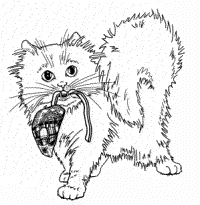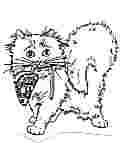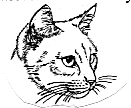 |
The Cat SitterSM TribuneMaking "Cat Sense" |
 |
||||
Issue Number 10*P.O. Box 232, Roswell, GA 30077*Phone: (770) 594-1010*Fax: (770) 967-4962* May, 1999 1999 Spring / Summer Issue |
||||||
Read this newsletter from front to back, or go
directly to the article of your choice: |
||||||
Good Litter Box Habits Begin with You Although it is obvious that The Cat
Sitter customers treat their precious kitties with the utmost respect and care, I have
developed an easy and effective litter box maintenance routine that you may want to try or
pass along to other cat-lovers. I have developed a litter box system that guarantees harmony in my house. It is based on the principles of easy and safe access, consistent cleaning, and simple methods and tools: Easy and Safe Access. My cats can easily get to their two large, deep litter boxes. They are in separate rooms and I keep the doors to these rooms blocked open. I do not keep covers on the litter boxes. Consistent Cleaning. I clean out both
litter boxes twice a day. Not only does this guarantee clean boxes, but it allows me to
monitor my cat's urine and bowel outputs, enabling me to recognize early warning signs of
illness. My litter box routine is simple and takes just 6 to 10 minutes a day. I consider myself fully litter box trained. My cats know I appreciate them just as much as I know they appreciate me, and that is the key to a wonderful relationship! Taylor is a sweet, friendly, in/outdoor 1 1/2
year-old female "tuxedo" cat in need of a loving home. To learn more about
Taylor, call The Cat Sitter at 770-594-1010. Taylor is now living in Atlanta. |
Notes
from Linda Congratulations Go Back to Top of Page The Cat Sitter has franchise opportunities in the Atlanta area.
If you're looking for a rewarding career doing something you love, this may be the job for
you! Only real cat lovers and owners need apply. The Cat Sitter has added a new logo to distinguish its cat sitting service from other services and products offered by The Cat Sitter.
Our new logo protects us as we grow and assures cat lovers everywhere that they are receiving premium "topcat" services. We are pleased to announce that our new Cat Carrier is now available for purchase. This unique, sturdy fabric carrier, designed by a true cat lover, is like no other carrier on the market. Features include: * Special padding for your cat's Prices begin at $99. You may place your order through The Cat
Sitter at 770-594-1010 and through some veterinarians and pet stores. |
A
Cat with Special Needs The aloof, independent cat is a stereotype promoted by those who have never shared their life with a cat. Every cat has a unique array of special needs. There is, however, a class of cats that can truly be labeled as having "special needs." These poor unfortunates have some physical challenges that prevent them from leading a normal life. This article is about one very special cat with "special needs." One day, we noticed a tiny, black kitten poking about the leaves at the edge of the woods near our home. After leaving some food outside for the little kitten, we were quite surprised the next day when the kitten's entire family appeared. The parents, gray tabbies, and their offspring, two midnight black kittens, continued to feed twice a day. The father of the litter was diminutive, except for his head. Tomcats tend to have heads larger than females of the same stature and weight. This fellow was one step beyond that, lending a visual cue to his name, Big Head Todd. As soon as we rescued the little family, we took Big Head Todd to our vet. We were dismayed to learn that Big had feline immunodeficiency virus (FIV). We checked the rest of the family immediately and all received clean bills of health.
The options for Big are limited. He is otherwise in good health, but because of his FIV, he cannot return to his family or be placed with other non-FIV cats without putting them at risk. Big is truly a nice cat and has socialized well with his rescuers. Before his rescue, Big lived in the woods with his family. He cared for them to the extent that his efforts fighting intruders probably lead to his contracting FIV. Many times before his rescue, we observed him with the kittens - grooming them, snoozing with them in the sun, or keeping a watchful eye on them. Big is looking for a home where he will be an only cat and where his adopter will understand his affliction. He has the stance of a bulldog - wide at the shoulders - as if he is ready to take on the world. His purr can only be described as a rumble, and he is quite talkative. We have trained Big to accept a harness so that we can take him outside for walks. It is probably his favorite activity. He is most happy when I groom him, twice a day, at each mealtime. He won't let me skip that part of our breakfast and dinner routine. It is a wonderful tranquilizer for both of us. Our vet says that it is very possible for Big's FIV to remain dormant for years, perhaps never becoming active. Big can have a life filled with walks and talks, lots of grooming, and evenings in front of the fireplace. Do you know someone with a big heart who is living without a cat? Their rewards will be without measure. Please call The Cat Sitter at 507-367-2500 for additional information about Big. Rags
to Riches The two most popular employees at Cummings' Books in Minneapolis haven't always raked in the cat treats. Both Attila and Artemis were homeless as kittens. Attila came to us in the winter of 1996, and Artemis the winter of 1997. Both keep busy when the shop is open by greeting customers, enhancing our window displays, and approving purchases (with a sniff). They also act as surrogate cats for the students at the nearby University of Minnesota, who were unable to bring their cats into the dorms. Attila has a shelf called "Attila's Picks," which houses such treasures as Outwitting Squirrels and How to Live with a Neurotic Dog. Profits made by a bookcase of discount items go directly to the furry duo (used for food, treats, and toys, of course). Attila and Artemis would love to see you! Be sure to stop into Cummings' Books at 318 14th Avenue, SE, Minneapolis (Dinkytown) and say "hello." The articles in The Cat Sitter Tribune, a biyearly newsletter, are the generous contributions of our customers, veterinarians, groomers, and cat lovers. We thank you all! If you have a cat story, tip, joke, book, or other cat-loving news you'd like to share, just fax or mail us and we'll be happy to include your contribution in an upcoming issue of The Cat Sitter Tribune. Fax: 770-967-4962 Mail: The Cat Sitter, P.O. Box 232, Roswell, GA 30077 Things to Remember When We appreciate as much notice as possible when you're scheduling our services - preferably 3 days notice for shorter trips (other than emergencies) and as much notice as possible for longer trips. Due to factors including insurance, the safety of your home, and the well-being of your cat(s), we ask that no cleaning service or outsiders be in your home for the duration of our service. Remember to call and let The Cat Sitter know that you've returned home. This will avoid an extra visit/expense. In the Atlanta market, we now have a voice pager for your convenience. |
The
Silent Disease There is an insidious disease which may be plaguing your feline at this very moment. This disease is widespread, begins as early as two years of age, and is unknown to many owners. The lesions from this disease can be well-hidden and may rob your kitty a lengthy life of carefree abandon. This dreaded affliction is dental disease. Dental disease is thought to affect over 60 percent of cats at three years of age and 80 percent of cats at six years of age. Oral signs of a mouth gone bad include: halitosis, tartar accumulation, reddened gumlines, gum growth over teeth, loose and missing teeth, sensitive teeth, cavities, and drooling. Systemic signs of dental disease may present as: decreased appetite and activity, increased effort in chewing, dropping food out of mouth during eating, facial swelling, nasal discharge, chronic infections, and irritability. Dental disease allows easy access of bacteria into the bloodstream. This bacteria can then create problems with the kidneys, heart, lungs, and other organs. Decreasing the access of this bacteria into the body can help your friend live longer and have a better quality of life in its senior years. Discovering your kitty has dental disease can be difficult. If you cannot look safely into your cat's mouth, it is important for your veterinarian to do a thorough dental assessment at every visit.
If your kitty does have signs of dental lesions, there are a multitude of therapies available. Therapies range from home care to professional dental cleaning, including fillings, root canals, and extractions. Your veterinarian will help guide you to the appropriate care for your individual situation. Help your feline friends live longer and happier - keep their teeth bright and white. Rainbow
Bridge Just this side of heaven is a place called Rainbow Bridge. When an animal dies that has been especially close to someone, that pet goes to Rainbow Bridge. There are meadows and hills for all of our special friends so they can run and play together. There is plenty of food, water, and sunshine, and our friends are warm and comfortable. All the animals who had been ill and old are restored to health and vigor; those who were hurt or maimed are made whole and strong again, just as we remember them in our dreams of days and times gone by. The animals are happy and content, except for one small thing; they each miss someone very special to them, who had to be left behind. They all run and play together, but the day comes when one suddenly stops and looks into the distance. His bright eyes are intent; his eager body quivers. Suddenly he begins to run from the group, flying over the green grass, his legs carrying him faster and faster. You have been spotted, and when you and your special friend finally meet, you cling together in joyous reunion, never to be parted again. The happy kisses rain upon your face and you look once more into the trusting eyes of your pet, so long gone from your life, but never absent from your heart. Then you cross Rainbow Bridge together… Do the Right Thing
Spring is here - the time of year when the female cat's reproductive cycle kicks in and litters of cute, little kittens abound. Though it is not very difficult to find homes for kittens, please consider the following 1997 figures from the American Humane Society: There are 4,000 to 6,000 shelters in the U.S. 8 to 12 million cats and dogs enter U.S. shelters each year Only 25% to 35% of shelter animals are eventually adopted Only 4% of cats are returned to owners by the shelters A fertile female cat can produce 3 litters each year There are 4 to 6 kittens per litter One cat and her offspring can produce 420,000 kittens in 7
years If you have spayed or neutered your pet - hats off to you! If
there are feral or homeless cats in your area - or that you may be feeding - consider
participating in a Spay/ Neuter/Release program to help end overpopulation. Call your
local shelter for more information. |




